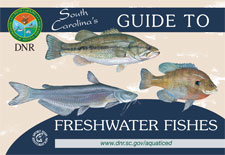Freshwater Fish - Species
Species Specific Regulations
Flathead catfish
Freshwater Fishing License required.
Flathead catfish (Pylodictus olivaris)
Description: (Anatomy of a Fish)
The flathead catfish is very large in size compared to other catfish in South Carolina. It has a broad and flat head with small eyes atop. The mouth's lower jaw sticks out farther than the top jaw. The flathead's body is mottled yellowish brown which fades to a gray belly. The upper tip of the square caudal fin may be white. This coloration is absent in large adults.
Range: The flathead can be found in the Pee Dee, Santee, Edisto and Savannah river drainages of the Coastal Plain and Piedmont.
Average Length: 15-45 inches
Average Size: 1-45 pounds
South Carolina State Record: 79 pounds, 4 ounces (2001)
Life Expectancy: Approximately 26 years
Preferred Habitat
The flathead catfish prefers deep holes in sluggish or slow water in medium to large rivers in areas with good structure such as fallen trees, stumps and undercut banks. Flatheads have also done well in large reservoirs, though growth rates tend to be slower in non-river habitats.
Food Habits
- Primarily a diet of fish.
Spawning
- In South Carolina, flathead catfish spawn from mid-May to mid-July in areas around hollow logs and undercut banks.
- The males create nests that are 3-15 feet in depth.
- The yellow gelatinous eggs masses that can contain 4,000 to 100,000 eggs are tended by the males. They guard and aerate the eggs with fin movements during incubation.
- Parental protection continues until the young fish absorb their yolk sacs and disperse.
Miscellaneous
The flathead catfish is an introduced species to South Carolina. Its native range is in the Ohio, Mississippi and Missouri river basins. Since its introduction into the Santee-Cooper Reservoir, flatheads have become established in nearly every reservoir or river system in the state. The spread of this non-native fish has negatively affected several native species, most notably redbreast sunfish. Although the flathead catfish provides a great sportfishing opportunity, the highly predacious flathead has negatively impacted native species such as bullheads and redbreast sunfish creating ecosystem imbalance. The flathead catfish maintain a solitary existence, usually inhabiting the same site on a daily basis. Like most catfish, the flathead catfish is a nocturnal feeder, becoming more active as light intensity declines. This fish makes excellent table fare. Unlike other catfish species, flatheads are reluctant to take decaying bait and prefer live bait.
Commonly Mistaken Species
Some species of fish that are commonly mistaken for this species are:
Literature Cited
Rohde, Fred C, Arndt, Rudolf G., Foltz, Jeffery W., Quattro, Joseph M. 2009. Freshwater Fishes of South Carolina. University of South Carolina Press, Columbia, South Carolina.
Wildlife and Freshwater Fisheries Division. 2009. South Carolina Guide to Freshwater Fishes.
Fish Illustration by Duane Raver.


